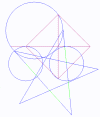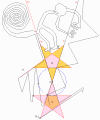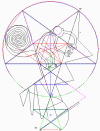|

by
Jiri Mruzek

|
Even a cursory inspection of the image reveals some intriguing symmetries.
These are no random scribbles, but a measured effort. For instance, check
the diagram above for the clearly intentional alignment along the bases of
the tail, and of the hands, and the tops of the sixteen lines forming a
grill on the right. This alignment is perfectly perpendicular to the central
axis of the X shape. I believe that Maria Reiche (Nasca's scholarly guardian
angel) would have noted this alignment. |
 |
After all we are working with her
copy of the desert glyph, and this alignment is strong, and obvious. In
contrast, the monkey's alignment to the cardinal points is also strong, but
cannot be shown with just a couple of lines. Both alignments suggest
alternative postures for the monkey, much different from the currently
prevalent baboon style, which has this spiral-tailed being tumbling on all
fours. Such presumptuous attitude has so far led to a complete
misunderstanding of what the monkey, and Nasca are all about.
Had Maria ever measured the angle of the X-shape?
|
The big X ( 'a' and 'b', the two longest lines) hugs visually exact 36
degrees, or one-tenth of a circle. See the similarity between the star
configuration on the left, and the monkey configuration on the right of the
diagram. There is identity of angle and of proportion, here.
This fact ignited my curiosity, as the 5-pointed star (36 degrees at each
point) is pivotal to
La Marche. More testing then led to sensational
findings. |
 |
Above all, the monkey's geometry is also the geometry of the
Athena
engraving. Its study is an ideal follow-up on the initial discovery, what
with the monkey's image being much simpler, yet in the same terms. As a
consequence of this simplicity, though, the monkey lacks the
self-explanatory quality of the Athena engraving. That is why a
mathematician uninitiated into its concept of a 5-pointed star would have
little chance of detecting it in the Nasca monkey.
Sharing of Hermetic Ideas
It is not easy to come to grips with the reality of Nasca's monkey. How can
it share key hermetic ideas with the Athena engraving from
La Marche? Here,
critics will retort acidly that it doesn't, and the sharing is all in my
mind. Rather than argue about the degree of my sanity, it is more effective
to prove the case graphically, using diagrams, which successfully merge two
separate realities - the artwork figure, and geometry. Here, success is
measured by ability to reconstruct the given artwork as a system, thus
simplifying the task.
At the start, there can only be simple geometries, elements like circles
derived from arcs in the image, all part of a standard procedure.
|
These elements are in position,
before the experimenter has any idea of what is going to happen. There is no
control over the result. If in the end the elements should add up to a real
system, which expresses real ideas, then this was once the designer's
thought.
The sharing of hermetic ideas begins with the two designs sharing the
basics. In the beginning, there has got to be a regular 5-pointed star, each
of whose arms is seen as five units long. The units are sometimes expressed
by unit circles (like the blue circles in the diagram right).
Then the 'Cone' (red and green) evolves from the star. |
 |
|
The square is constructed from the
Cone as above, with the circles drawn.
The cone below shows the two instrumental circles. The rest of the image is
then based on this layout (cone & square).
Since such matching of systems cannot be accidental, it works as a stamp of
authenticity under authority of a mysterious prehistoric advanced
civilization. Let us call it the
Seal of Atlantis.. |
 |
Initial Testing for Geometry
The copy of the Nasca monkey we use was originally published by
Maria Reiche.
She had first learned about the giant figure of a monkey on the pampa from
commercial pilots in 1952. It was to become her favorite figure, and
apparently her measurements of it were especially meticulous.
Of course, once I saw that the monkey is balanced within a 36 degree angle,
I wanted to see if there are other resemblances to La Marche, such as a
given 5-pointed star setting units of length.
The Pipe-Dream Test
The biggest thrill, the moment of truth had arrived right in the beginning.
Had this first computer assisted test not worked out, my visions of a
5-pointed star would vanish from the image, and that would have been the end
of it.
The Big X
|
The Monkey stands between the top branches of a giant X shape (the Big X).
In the test, the two lines of the Big X (a,b) had to show a rather precise
angle of 36 degrees.
I drew a straight line through line 'a' of the X, and got a beautiful match.
One line disappears under the other. Then I rotated this new line 36 degrees
about the X-Point towards the shorter line 'b', and the two lines merged
into one (the rotated line shows in red through the black line "b").
The X matches the 36
degree angle to the imperceptible two one-hundredths of a degree.
|
 |
Therefore, the X should fit into a circle ten times without
noticeable overlap - as it does in the diagram below. Whosoever had made the
big X to fit around a circle an even ten times, had also made sure that one
monkey should fit another unambiguously just as well.
This brings us to the next question - Does this 36 degree angle indicate
that we should look for a 5-pointed star of one particular size (like in the
La Marche engraving)?

Our experimental 5-pointed star will emanate from the X-point, the center of
the Big X. Let the line 'c' set its size. The rest is matter of automatic
completion. This first star is the X-Star-1.
|
X-Star-2 is a mirror image of the first star, as seen through the X-point.
X-Star-3, is a mirror image of X-Star-2. But, if we dropped this star onto
the Big X from above, it would slide to the same position as well. This
X-Star-3 casts itself upon the monkey's figure so well that it is named the
'Monkey Star'.
The bigger star made from the Monkey Star obviously has a good fit to the
end of line 'a'. In fact, if we reshaped the round bend at the top of line
'a' into a sharp corner, odds are that the star's end would coincide with
the line's end with utter visual precision. |
 |
The Monkey Star, we find out later, is equivalent to the original star
behind the Cone & Square configuration in the engraving from La Marche.
The Big X & the Golden Mean
The shorter part to the longer one is
as the longer part is to the whole thing.
The Big X's proportions approximate the Phi-ratio:
If the X-Star's arm is 1 unit long, the big star's arm is 2.618.. units
long, Phi squared.
|
The above diagram shows two overlapping sets of stars, but it looks as if
there is only one set because the two sets are nearly identical. Each set
comprises one small and one large star emanating from the X-point.
a) The larger red set bases upon the length 'X - ac' of the X-Star1.
b) The slightly smaller blue pair of stars derives from the distance 'X - ar', the most distant point found on 'a' by a ray sweeping around the X-Point.
Although created independently of each other, there is some visible
separation between the two only at a considerable distance above the
X-point, and none below it on the shorter section. A thing to consider here
is that if the curve above the X-ar point should be refolded into a sharp
corner, the two sets might actually be identical.
|
 |
The Star Launcher
The Big X can be used as guide-rails for expansion of 5-pointed stars in
both directions from the X-Point.. As the stars slide out, suddenly, a
number of points comes up to meet the expansion almost simultaneously.
|
Each of these points suggests a similar size for our experimental 5-pointed
star, the X-Star. This is just more confirmation that we are doing something
right.
The diagram right side, shows eight of these points (point 1 to 5, and 8 to 10).
Points 6 and 7 demonstrate more symmetry through the X-Point. |
 |
|
The Second Inverse Cone
Geometrically, the Big X represents an inverse cone. Another important big X
is formed by the line 'c' at 60 degrees to the line '1' (diagram below).
Altogether 'c' holds 60 degrees with half of the sixteen parallel lines of
the grill shape. This second big X in the image also invokes a regular
figure - the equilateral triangle. |
 |

The star's center closely coincides with the center of the monkey, whose
head, hands and feet orbit it along the star's circumcircle. The head and
the feet also press against the star's pentagon. The monkey straddles the
imaginary central axis of the Big X as if it really were there.
|
Finally, the monkey's
spiral tail also fits the star grid lines. Overall, this is a great
balancing act on two feet. Facing towards the Pacific, the monkey
appears focused on its hands, which are close together, as if doing
something with both hands using the 'precision grip'. I can imagine
the monkey playing bagpipes, or hiding behind a round shield ( the
Monkey Star's circum-circle), walking a treadmill-wheel, dowsing,
catching a football, etc. In another impression, the Monkey
ensconced in its winged star, soars high above the Nasca desert. |
 |
|
The Wheel of Five Tumbling Monkeys
This is another obviously successful experiment. The figure was arrayed five
times around the Monkey Star's center. It joins the 'chain of ten monkeys'
in the gallery of fully functional five-fold arrays, one for each main point
so far. How noteworthy, two wild stabs in the dark produced two big strikes
- intrinsic art on a high level of participation by the explorer. The fact
assails the idea of this art being due to wild luck. |
 |
The Monkey's head, hands, and feet are evenly distributed with respect to
the Monkey Star's center.
The hands clasp the head like a pro holds his basketball. We also see a
perfect regular pentagram. _ Skeptics will automatically laugh, and object
that any line put into a five-fold array - will produce a five-pointed star,
or a pentagon. - True, but here, we have two separate lines, each in a
five-fold array, ten lines in all. Yet, we see one regular 5-pointed star
only, and five lines - not two stars!
So, this is a special case, when lines merge in a given array, because of
holding the required angle.
(Nice try, though :-)
Polar Opposition of Genders
The transformation above is shown upside down below. The Monkey's image was
mirrored along the line (a) of the Big X. It strikes me that whereas at the
center of the image above I see a likeness of a warrior, hooded, and in a
conical hat - the same image upended as below, and colored in a little
differently, evokes a convincingly female form. Somewhat strangely, the
warrior's hooded vest is streamlined like a jetfighter. There is also a
cockpit.
In my opinion, each of these likenesses reinforces the other.
|












